
Wildlife Program report: Feb. 1-15, 2024
Conserving Natural Landscapes
The final Violet Prairie Section 6 Management Plan was delivered to the U.S. Fish and Wildlife Service, as a grant requirement under the Cooperative Endangered Species Conservation Fund. The property will be managed in perpetuity for the benefit of federal and state listed species, specifically the Yelm pocket gopher and the Taylor’s checkerspot butterfly. Planning and Recreation staff members developed the plan in collaboration with the wildlife area manager, Region 6, and Diversity Division staff members. Management activities featured in this plan include prairie restoration, forest management, noxious weed control, grazing and recreation. Grazing, identified as a management tool in the plan, will be introduced on the unit this year.
The route inventory contract is currently up for bid and will close in March. Planning and Recreation Section staff members are holding a pre-bid conference for interested organizations on Feb. 14.
Providing Education and Outreach
The Ambassador Program contract is currently up for bid and will close in March. Planning and Recreation staff members are still working with the tribal liaison to design tribal acknowledgment monuments. We have also been working with Director of External Affairs Pamplin, Director of Tribal Affairs Woods, and others to re-word some things on the Plum Access Area kiosk that includes a narrative about the Snoqualmie Tribe. There are about 20 water access area kiosks in the design phase.
Managing Wildlife Populations
Lynx Monitoring: Wildlife Biologists Prince and Turnock participated in two meetings about lynx monitoring in the Kettle Mountains of northeast Washington. A large effort for monitoring lynx occupancy and snowshoe hare abundance (still in the works) within the Kettles may begin this summer depending on funding and staff availability. Entities involved include the Confederated Tribes of the Colville Reservation, U.S. Forest Service, Washington Department of Fish and Wildlife (WDFW), U.S. Fish and Wildlife Service, Washington State University, and Conservation Northwest.
Elk Damage: Natural Resource Technician Nizer and Wildlife Conflict Specialist Harris met with two producers in northeast Whitman County that were having elk damage on their crops. Nizer talked about the access program and how that could help mitigate the elk damage. Harris talked about the Damage Prevention Cooperative Agreement (DPCA) and how it works well with an access agreement. Both producers were interested in the program. If they agree to a contract, it will add about 1,000 acres in the Hunt by Reservation Program and 300 acres in the Hunt by Written Permission Program for elk and pheasant hunting access. Nizer will follow up with landowners to see if they want a contract worked up.
Elk: Biologist Brinkman and other biologists from Region 1 traveled to an elk feeding site outside of Ellensburg to participate in immobilization training with Wildlife Veterinarian Mansfield and other WDFW staff members that have extensive experience in capturing ungulates. The purpose of this training was to practice working through the department capture protocols and datasheet that will be used on moose captures next week.


Providing Recreation Opportunities
Hunter Contact: Wildlife Conflict Specialist Wade was contacted by a quality elk tag holder. Wade assisted with locating potential areas to hunt during the 2023 muzzleloader season. The hunter reported that he sent teeth from his elk to a lab in Montana to be aged and wanted to share the results. Wade also answered several questions for the hunter regarding potential hunts for the coming year.
Providing Conflict Prevention and Education
Radio Activated Guard Box (RAG) Check: Wildlife Conflict Specialist Wade traveled to the Grande Ronde to check on the RAG box that was deployed last week, in a feedlot that has had recent wolf activity. The RAG box was functioning properly, and all cattle observed were calm and feeding.
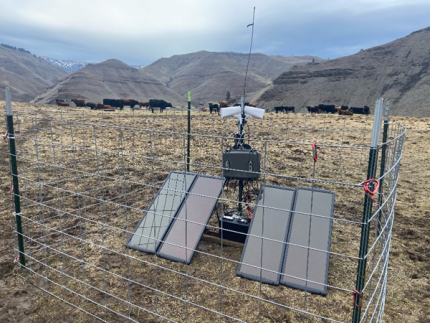
Deer Damage: Wildlife Conflict Specialist Kolb received a complaint of deer damage to a cherry orchard in Walla Walla County. A site visit was conducted, and damage permits were issued in an effort to mitigate further damage.
Conserving Natural Landscapes
W.T. Wooten Wildlife Area – Tree Planting: Wildlife Area Manger Dingman and Natural Resource Technician Tritt worked on planting ponderosa pine trees at the Rainbow Lake spoils site. The trees will replace the trees that were removed from the dam on the north end of Rainbow Lake. Two of the staff members at the Tucannon Fish Hatchery stopped by and helped plant the last 12 trees.
Channeled Scablands Habitat Conservation - Outreach Kick-off Meeting: Wildlife Area Finch attended a meeting regarding the Channel Scablands habitat conservation. The purpose for the meeting was to discuss the next steps for wetland habitat conservation after the Waterfowl Spring Migration Survey and Report project in the eastern Washington Channeled Scablands. Everyone that attended the meeting was trying to come up with ideas for how to advertise conservation to private landowners. They want it to be appealing for landowners to develop their property for habitat conservation for waterfowl migration.
Providing Education and Outreach
Bear Outreach and Education: Biologists Lowe and Brinkman attended the second Grizzly Bear Information, Education and Outreach Summit in Coeur d’Alene Idaho. The workshop included 120 participants from several state and federal agencies, two provinces, non-profits, businesses, county representatives, and community members.
Public School Visit: Sherman Creek Wildlife Area Assistant Manager Palmer conducted an annual visit to the Kettle Falls Elementary School, to teach 4th grade students about wildlife interactions. The entire grade of about 50 kids was broken up into four groups: Eagle, Wolf, Cougar, and Deer, where they learned about their animal’s life history.
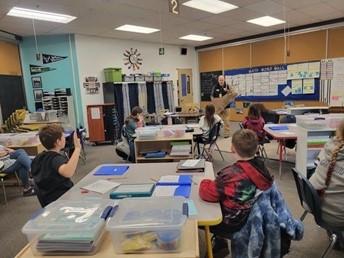
4th Grade Animal Experts: Wildlife Biologists Prince, Turnock, Bennett, and Palmer served as experts to 4th graders at Kettle Falls Elementary School. They shared information and answered questions about bald eagles, cougars, white-tailed deer, and wolves.
Waikiki Springs Eagle Scout Project: Access Manager Dziekan met with a boy scout to sign off on a project proposition so that the scout troop can begin working on it. This project has been in the works for some time now. With Dziekan’s signature agreeing to the project, the boy scout will begin building and installing an informational kiosk at Waikiki Springs Wildlife Area. This kiosk will be installed at the lower portion of the wildlife area to compliment the kiosk at the trail head, which was also an Eagle Scout project. The boy scout has the funding secured to purchase the materials. Once the scout has acquired everything that is needed, Dziekan will schedule a time for the scout and a trusted adult, since the scout is under 18, to meet at the WDFW Region 1 shop and use the workspace and tools to build this kiosk.
Conducting Business Operations and Policy
Equipment Maintenance: On Feb. 1, Sherman Creek Wildlife Area Assistant Manager Palmer turned over two old snowmobiles to the gentleman who bought them from state surplus. Palmer also changed the oil filter on one of the newer snowmobiles assigned to Sherman Creek Wildlife Area.
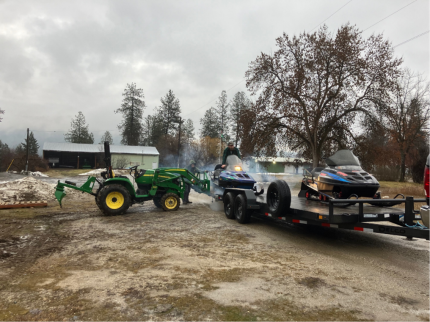
Managing Wildlife Populations
Waterfowl: Biologist Clements attended the quarterly Washington Waterfowl Association Moses Lake Chapter meeting on Feb. 8. Clements gave a recap of the successful hen mallard nesting tube reconstruction project and offered another volunteer project of monitoring the tubes for any nesting activity starting in March.
Greater Sage-Grouse and Sharp-Tailed Grouse: Biologist Eilers mailed out letters to private landowners in Douglas County asking for land access permission to survey grouse on private property. Biologists will be searching for new greater sage-grouse and sharp-tailed grouse leks. They will monitor known leks across Douglas County to get population estimates of these species.
Douglas County currently has the greatest abundance of greater sage-grouse in the state of Washington. Unfortunately, populations are declining.
With the warmer temperatures and lack of snow this winter season, greater sage grouse are displaying at lek sites a few weeks early this year. Biologist Eilers and Hunter Education Coordinator Montanari completed the first lek counts in southern Douglas County near Alstown and the Badger Mountain area. The grouse lek near Badger Mountain has consistently been the most well-attended with up to 30 males displaying on some mornings in 2023, and it’s off to a good start this year with the highest count yet of 37 birds.
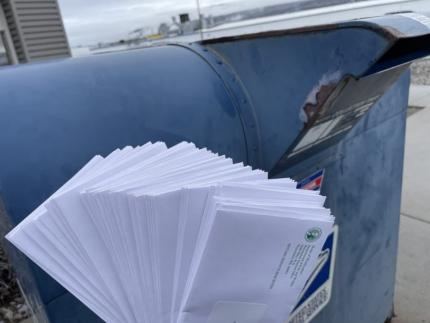

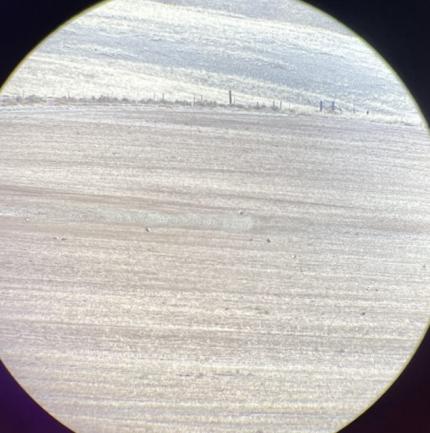
Sharp-Tailed Grouse Monitoring: Biologist Heinlen surveyed the winter habitats of sharp-tailed grouse (Tympanuchus phasianellus columbianus) finding a total of 28 birds foraging in the water birch (Betula occidentalis) trees in the Siwash Creek area. This is five more birds than were counted during the area’s spring lek surveys last year. It’s probable that there is at least one unknown lek in the area we have yet to document. Water birch catkins (seeds) are a primary food source for sharp-tailed grouse in the district making them an important component of sharp-tailed grouse habitat.
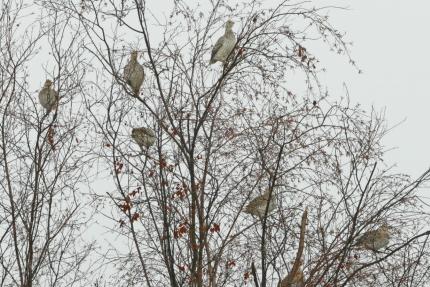
Mule Deer: Biologists Jeffreys and Eilers retrieved two GPS collars from mule deer to down-load data stored onboard. Between 2020 and 2022, more than 60 does were collared in Chelan County as part of an ungulate movement and migration study being conducted in several Washington herds as well as across the western United States.
Biologists have used location data gleaned from these GPS collars to learn valuable information about timing and duration of migration, migratory corridors, stopover points, and winter and summer range use for mule deer wintering in the Wenatchee Foothills as well as the Nahahum Canyon, Burch Mountain, and Swakane areas. These collars were programmed to drop off in four years after deployment, so the last 12 collared does still standing since the January 2020 capture dropped their collars as scheduled last month. Many are still inaccessible due to snow cover and land access, and biologists will continue to retrieve them over the upcoming months. Washington Department of Fish and Wildlife will continue to receive GPS data from the 13 active collars in Chelan County for two more years.
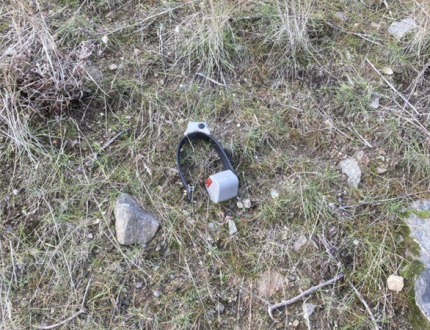
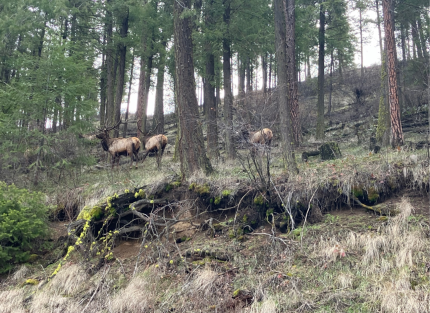

Pygmy Rabbit Winter Surveys: Staff members started out the year carrying out pygmy rabbit surveys in the Sagebrush Flat Wildlife Area. With a mowing and prescribed burn project on the horizon, they took advantage of the limited snow and conducted burrow surveys to inform staff members of the best areas for land management. While there have been no pygmy rabbit sightings in the project area, staff members have flushed several sage grouse and short-eared owls. Wildlife staff members will continue to work collaboratively with the pygmy rabbit recovery crew assisting with surveys outside of the project area.
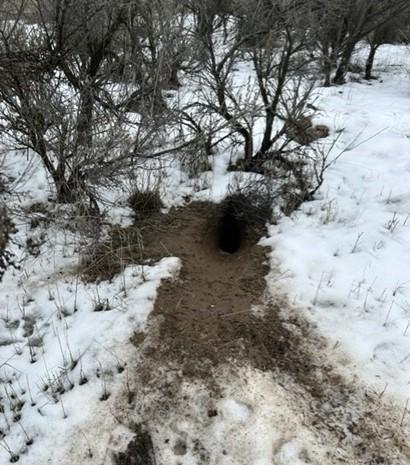
Pygmy Rabbits: Biologist Clements led a group of Washington Conservation Corps members and the pygmy rabbit team members finish up burrow surveys on a parcel known to have active pygmy rabbit sites. The team successfully completed the remaining transects, and despite the lack of snow making burrows easier to identify and muddy terrain, they were able to identify multiple burrows and collect fecal samples to send off to the lab for genetic analysis.
Bobcat Research Assistance: Biologists Fitkin and Heinlen assisted Biologist Welfelt with a multi-day deployment of several dozen remote cameras as part of an ongoing research effort examining bobcat and lynx seasonal habitat use dynamics. Cameras were deployed from the valley floor on the Sinlahekin Wildlife Area to over 6500 feet on the divide between the Methow and Okanogan watersheds. Data collection will continue for another year, and in addition to bobcat and lynx, the cameras are gathering data on a variety of additional species of interest.
Additional thanks to retired Washington Department of Fish and Wildlife Biologist Base for helping with this effort.
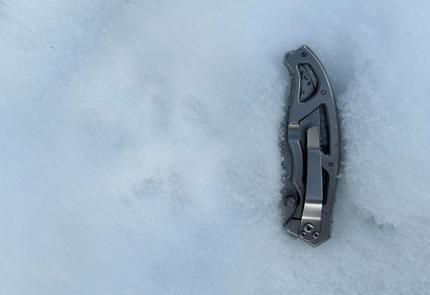

Providing Recreation Opportunities
Water access staff members have been putting the newly acquired Bobcat mower arm to good use. Assistant Manager Steele, and Natural Resource Technicians Wilson and Blanchard have been able to mow previously hard to reach and access roadsides and tracks where traditional tractor mowing hasn’t been an option ahead of spring residual herbicide application. This was done at the Quincy Lakes Wildlife Area with both the Bobcat mower arm and the new Bobcat Mini Track 100 (MT 100). The mower and MT 100 were also used at the Lake Lenore fish trap for mechanical control of tall emergence vegetation. Steele and Blanchard also removed a fallen tree and repaired a damaged fence at Blue Lake in Grant County.
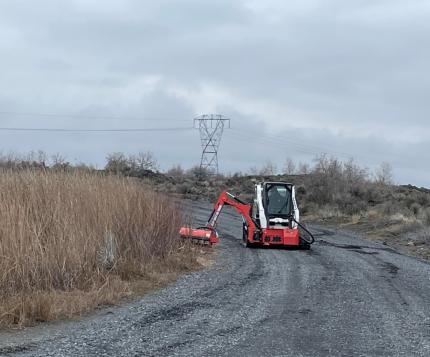
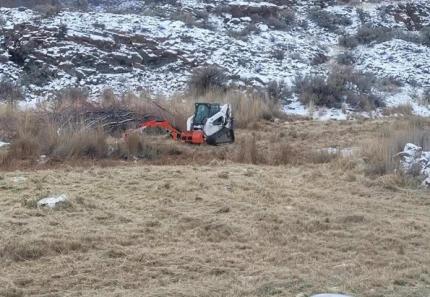
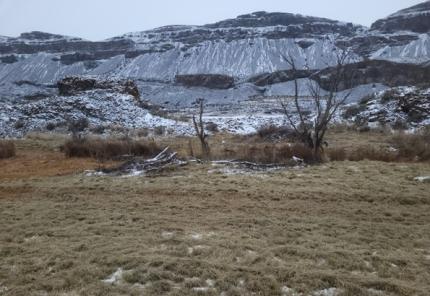
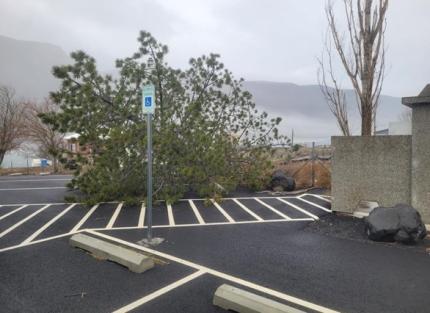
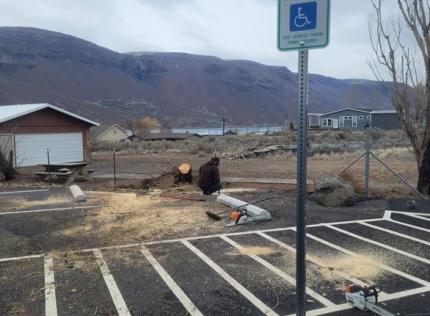
Conserving Natural Landscapes
West Foster Creek Beaver Dam Analogue Project: During late summer and early fall, wildlife area staff members installed around 50 beaver dam analogs on West Foster Creek near Bridgeport. These beaver dam analogs were revisited when staff members were alerted by Douglas County Public Utility Department Biologist Schilling that they had salvaged a large bounty of free Christmas trees. Wildlife area staff members repurposed 55 trees that were going to be discarded at Fred Meyer and another 60 from Home Depot.
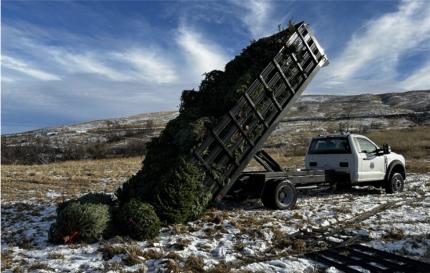
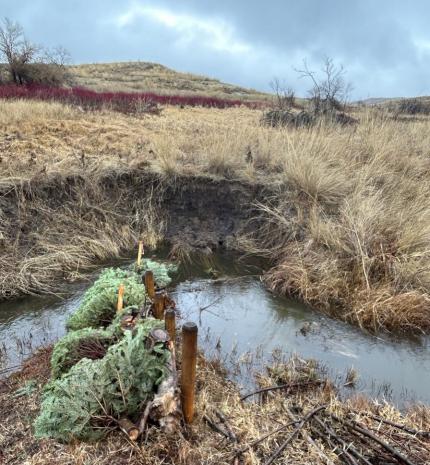
Big Bend Restoration: When reflecting on accomplishments of the past year, staff members recall the all-hands-on deck effort to prepare seed, plant, and spray restoration fields at Big Bend in late fall. This work was across the Magers, Bissell Flat, and Back Rock Lake units. In total, staff members drill seeded 261 acres with native grass, 43 acres with native forbs, and planted 5-1/8-acre forb plug islands across another 30 acres. Each field was approached differently, with the most intensive restoration occurring at Back Rock. The Back Rock restoration fields required six staff members to work long hours mowing, harrowing, spraying, and drill seeding to complete the project before winter conditions took hold.

Other
Administrative Work: Biologists Dougherty and Clements attended the quarterly meeting with the Bureau of Reclamation to discuss updates within both agencies. Biologist Clements mentioned that she heard discussion of replacing panels within the canal near the Pinto Ridge Dam. She suggested that as parts are replaced, finding potential wildlife friendly options would be helpful to aid in deer that consistently end up stuck in that stretch of the canal.
Ground Squirrels: District staff members attended a meeting regarding the 2023 Washington ground squirrel survey efforts and to offer suggestions of future projects and next steps for this species.
Northern Leopard Frogs: District staff members began the process of selecting and interviewing candidates for scientific technician positions. When filled, these positions will assist in northern leopard frog recovery work. The new hires will be onboarded and ready to start the busy field season in April.
Shipping Container Improvements: The shipping container that is used to store seed for restoration fields has undergone significant improvements. Maintenance Mechanic Rios prepped the unit so that he could install a heater and air conditioning unit. This task ensures improved temperature control for seed and other materials stored in this unit.
Headquarters Reflooring: What was supposed to be a simple reflooring project at headquarters proved to be more exciting than anticipated. While peeling up the old flooring, Maintenance Mechanic Rios was surprised to find six gopher snakes deep in their hibernacula in a small space that had been created under the floor of an office space.
Assistant Manager Blake sought council from District Biologist Jeffreys and Fitkin who recommended she speak with Beck, a retired herpetologist and professor from Central Washington University. After seeking consultation, she decided to keep them contained in the correct environment to ensure they winter in the proper conditions.

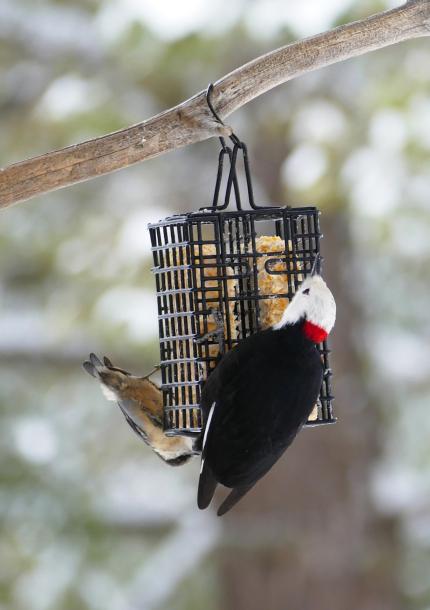
Managing Wildlife Populations
Cougar Sealing: District 4 Wildlife Conflict Specialist Hand sealed a cougar for a hunter who harvested it in the Blue Mountains GMU 156.
Bobcat Sealing: District 8 Biologist Wampole sealed a bobcat harvested in Kittitas County.
Wolf Monitoring: District 8 Biologist Wampole set additional camera traps to monitor wolf activity in Kittitas County following the observations of tracks.
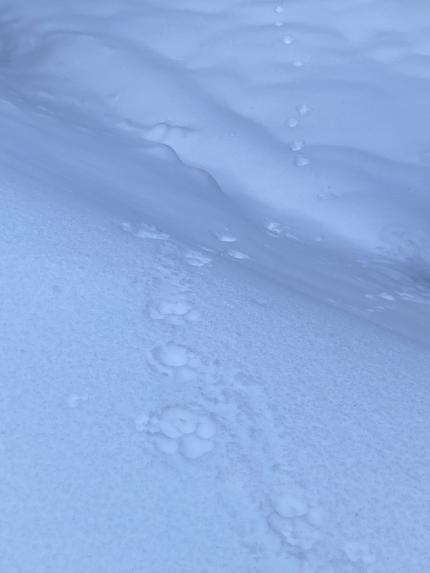
Rattlesnake Hills Elk Survey Completed: District 4 Wildlife Biologist Fidorra completed surveys for Hanford elk herd with the help of District 8 Biologists Wampole and Moore. Flight photographs of groups were taken and still need processed before herd numbers are updated.

Oak Creek Wildlife Area: The winter elk feeding program continues on the Oak Creek Unit and Cowiche Unit of the Oak Creek Wildlife Area. Elk are in seasonally good health and are monitored daily throughout the feed season. Winter weather has been mild through the beginning of February 2024. Elk are moving in and out of the feed site daily. Additionally, they are seen grazing away from the feed sites. However, Oak Creek staff members continue to feed approximately 2300 elk on the Cowiche Unit and 650 elk on the Oak Creek Unit daily.

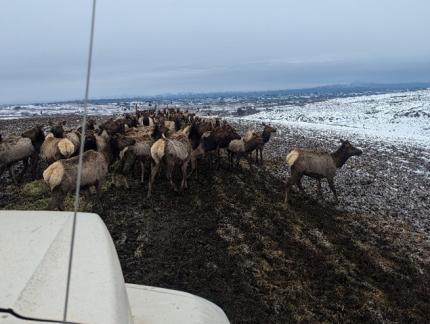
Pelican Diet Study: District 4 Wildlife Biologist Fidorra joined Region 3 fisheries staff members and Olympia Diversity Program and Science Program staff members for discussions with the Yakama biologists regarding a diet study on white pelicans and interactions with salmon smolt and predatory fish.
Audubon Climate Watch Point Counts: District 4 Wildlife Biologist Fidorra assisted a local Audubon chapter on a morning of long-term point counts in Benton County. The work was part of the National Climate Watch project that tracks changes in bird species distribution related to climate change.
Eagle Carcass Testing and Avian Influenza: District 4 Wildlife Biologist Fidorra assisted with responding to three separate eagle mortalities in the Tri-city area. Avian influenza (AI) testing was conducted on two of the three birds with one positive and one negative result. AI has been an ongoing concern for wildlife in the area over the past two years.
L.T. Murray Darting Training: Wildlife Veterinarian Mansfield put on a large ungulate darting training at the L.T. Murray’s Joe Watt feed site. Several elk were darted, and samples were taken.

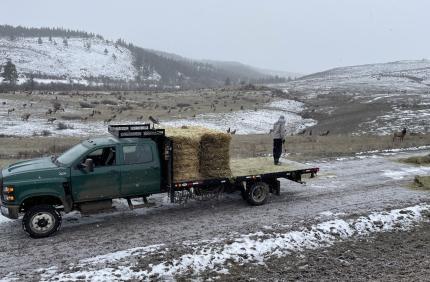
Providing Recreation Opportunities
Wenas Wildlife Area All Trails Public Lands Program: Wenas Wildlife Area Lands and Recreation Specialist Frame are now working with All Trails via their Public Lands Program to help manage the recreational trails throughout the Wenas Wildlife Area.
This program was created by All Trails to work with land managers (federal, state, city, and private). With this program, the Wenas Wildlife Area will be able to give critical information regarding trails in the area such as, trail closures, emergency restrictions, seasonal closures, accurate trail descriptions, etc. The program will also help with data collection such as trail use and popularity.
Sheep Company Road Target Shooting Area Clean-Up: Wenas Wildlife Area Lands and Recreation Specialist Frame collected 510 pounds of trash and target shooting material. Most of the items were targets used incorrectly by the public. Items include wood pallets, cardboard, metal, brake rotors, and paper. Frame also removed a deceased and partially butchered domestic pig and three buckets of paint primer from the horse parking area on Sheep Company Road.
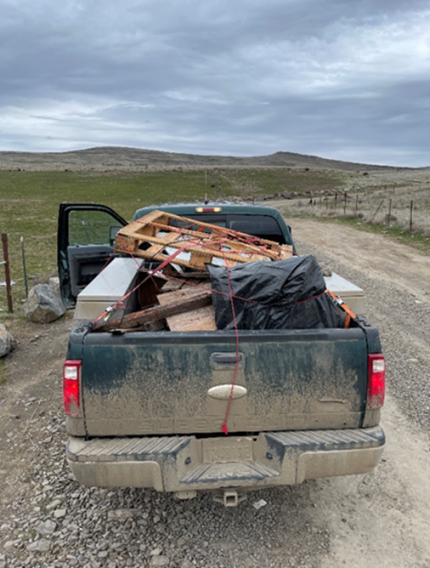
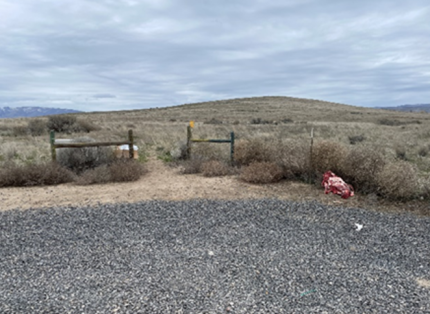
Kiosk and Parking Area Development: Wenas Wildlife Area Technician Janes and Assistant Manager Taylor laid out barrier rock just past the lower Buffalo Road gate and installed a kiosk this winter. This is a second parking area lined out for the road. Increased signage is needed because it is a popular area used for hiking. Wenas Wildlife Area Manager Gray coordinated with the Department of Natural Resources on the kiosk installation and barrier rock placement.
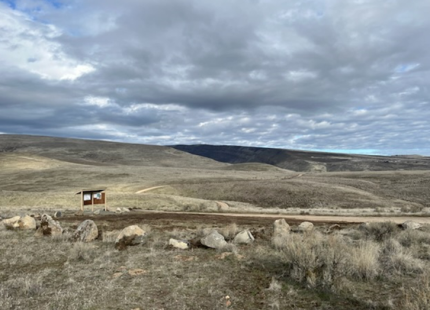
Providing Conflict Prevention and Education
Rattlesnake Hills Elk: District 4 Wildlife Conflict Specialist Hand monitored for elk activity on the Hanford National Monument and adjoining private lands. Large numbers of elk continue to occupy low elevation areas near Highway 240 on the Hanford Monument.
Deer Damage and Youth Damage Hunt Opportunities: District 4 Wildlife Conflict Specialist Hand deployed youth from the Region 3 special permit roster to Kahlotus area landowners experiencing deer damage in their wheat fields. Hand continued coordination on hazing, permit issuance, and reporting. Additionally, a landowner along the Yakima River has requested youth hunters for hazing and removal efforts.
Possible Cougar Observation in Finley: District 4 Wildlife Conflict Specialist Hand assisted a local Washington Department of Fish and Wildlife Enforcement officer with a call concerning a cougar observed near Finley. The area was canvassed for signs or evidence of cougars, but nothing was located. They provided the homeowner with information concerning cougar behavior and asked the homeowner to let them know if it returns.
Dumped Elk Carcass: District 4 Wildlife Conflict Specialist Hand assisted local Washington Department of Fish and Wildlife Enforcement staff members with the investigation of elk parts and garbage that were dumped near Horn Rapids Dam.
Kittitas County Conflict: Conflict Technician Leuck and Conflict Specialist Wetzel hazed some elk from areas in Kittitas County. Elk ventured into areas in Thorp, Vantage, Kittitas, Badger Pocket, and Cle Elum. They were mostly visiting haystacks and domestic animal feeding areas. Elk have been hazed away from I-90 in some locations.
Wetzel also worked with a nuisance wildlife control operator on a skunk issue in the city limits of Roslyn.
Yakima County Conflict: Conflict Technician Leuck and Conflict Specialist Wetzel repaired elk fence in the Cowiche area where elk were in orchards outside the elk fence. Elk were hazed from Tampico and the Tieton areas as well.
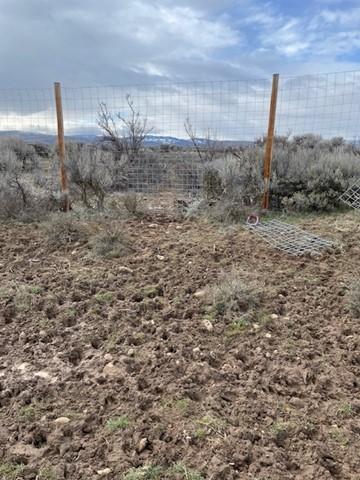
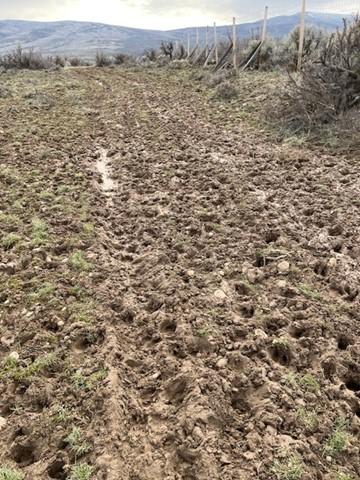
Presentation to Wildlife Area Volunteers: District 8 Biologist Wampole presented to Oak Creek Wildlife Area visitor center volunteers on the status of Yakima elk and management challenges. In addition, Wampole showcased information on the on-going test and remove bighorn sheep study being carried out in the Selah Butte/Umtanum and Cleman Mountain herds.
Conserving Natural Landscapes
Sunnyside Cleanup: Sunnyside-Snake River Wildlife Area Assistant Manager Ferguson and Natural Resource Technician Cardenas cleaned up dumped mattresses and other trash and installed a new cable gate at a road pull-off that was being targeted for loitering and garbage dumping recently. Hopefully the new gate will prevent further illicit activities.
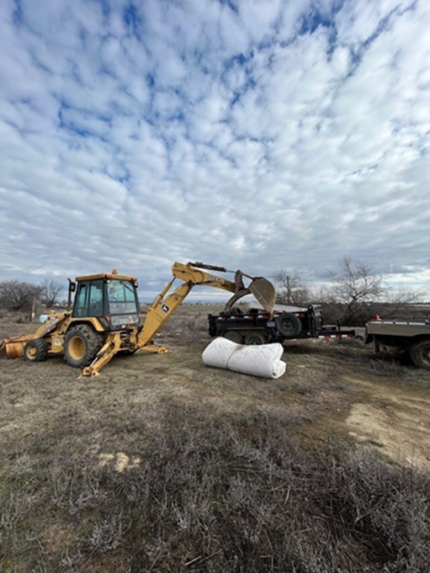

L.T. Murray Parke Creek Culvert: L.T. Murray Wildlife Area Natural Resource Technician Blore and Manager Morrison worked with regional Habitat Program staff members to access a small culvert in Parke Creek that has failed in two spots.
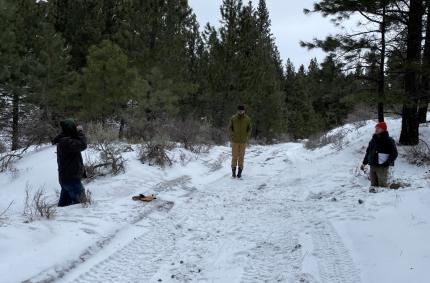
Providing Education and Outreach
Oak Creek Wildlife Area Visitor Center: The Oak Creek Visitor Center continues to open daily from 10 a.m. to 4 p.m. with feed site tours available from 11 a.m. to 3 p.m. daily. The visitor center is completely staffed and operated by a group of volunteers, The Friends of Oak Creek Wildlife Area. As of the first week of February, they had conducted 210 tours and had approximately 4097 people visit the center.
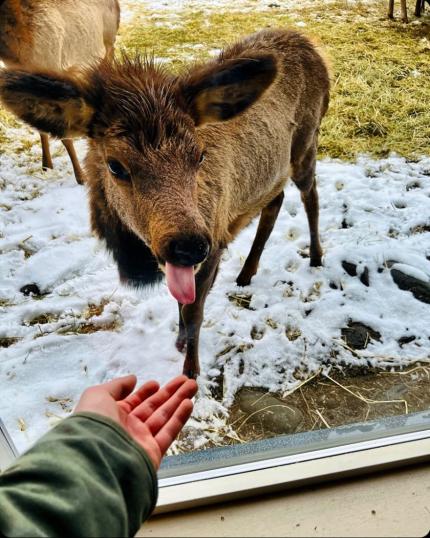
L.T. Murray Outreach: L.T. Murray Wildlife Area Natural Resource Scientist Nass and Manager Morrison held two outreach events at the Joe Watt feed site for Thorp Elementary School students and home school students. Both groups played games for ecological education followed by group discussions.

Conducting Business Operations and Policy
Safety Stand-Up meetings: District 4 Wildlife Biologist Fidorra met with the Region 3 Wildlife Program supervisors as well as the Pasco Wildlife Program team to discuss safety and personal protective equipment. Several items were purchased to improve safety including personal floatation devices and supplies for vehicles.
District 8 Wildlife Capture Training: District 8 staff members, Wampole, Moore, and Wetzel participated in capture training of elk at the Watt and Robinson feed sites. Training was led by senior biology staff members and Wildlife Veterinarian Mansfield on safe capture operations to protect wildlife and human health and ensure data quality.
Other
New Staff Hired: District 4 finally has their first assistant district wildlife biologist! Biologist Hoffman started on Friday, Feb. 16 and will be helping to build capacity on Diversity Program projects for species including burrowing owls, ferruginous hawks, ground-squirrels, and other shrub steppe species. Blake attended the University of Montana for his BS in Wildlife and has nearly completed his master’s degree from Northern Arizona University on ringtail management at Grand Canyon National Park. Prior to this work for the National Park Service, he held various positions contributing to wildlife research in Idaho, Montana, and Colorado. His diverse background includes work with small and large mammal trapping, survey design, songbirds, bat mist-netting, chemical immobilization and veterinary experience. Having grown up enjoying the Washington outdoors in Chelan County, Hoffman is happy to be moving back to his home state with his wife. Please help WDFW in welcoming Biologist Hoffman as he settles into this new position based in the Pasco District 4 office.
Sunnyside-Snake River Wildlife Area Truck Maintenance: Sunnyside-Snake River Wildlife Area Assistant Manager Ferguson and Natural Resource Technician Cardenas installed new wooden side boards on wildlife area dump-bed truck International 4700, replacing broken boards. The truck is used for hauling gravel and other materials around the wildlife area for various projects.
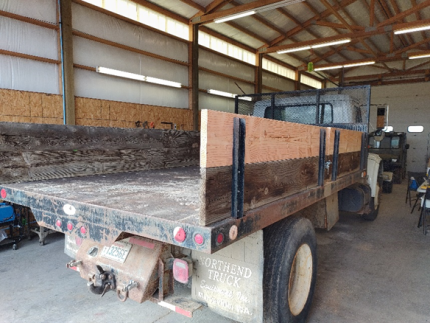
Managing Wildlife Populations
Bat Hibernacula Surveys: Biologists Wickhem, Stephens, Bergh, and Holman along with Private Lands Biologist Grey and Assistant Regional Wildlife Program Manager Hauswald joined with staff members from the U.S. Forest Service and several volunteers to conduct bat hibernacula surveys in the Gifford Pinchot National Forest and adjacent private lands. The effort was organized and led by Wildlife Diversity Division Species Lead Tobin and Wildlife Diversity Survey Section Manager Cotten participated as well.
The teams skied, snowshoed, snowmobiled, and hiked several miles and surveyed many caves where they counted and identified species of bats roosting in each cave. When bats from the genus myotis were found within reach, the bats were directly swabbed to test for the fungus that causes white-nose syndrome. These surveys are part of a larger effort to survey a portion of the more than 600 caves within the Gifford Pinchot to see which support hibernating bats. They are especially interested in Townsend’s big-eared bats which are a Washington Species of Greatest Conservation Need (SCGN) and a Priority Species under Washington Department of Fish and Wildlife’s Priority Habitats and Species Program.
Thanks to Biologist Tobin for her organizational focus, many outdoor skills, attention to safety as well as biosecurity to address potential transmission of white-nose syndrome, knowledge of all things bats, and overall leadership on this large-scale effort.
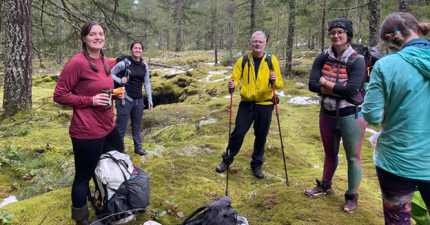
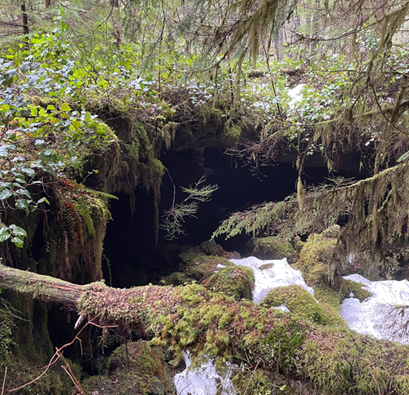

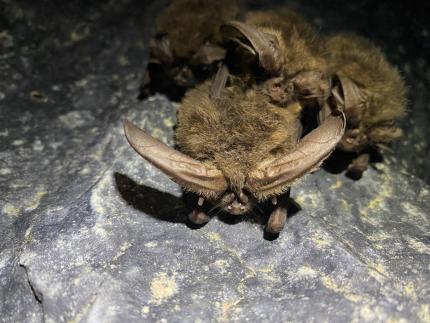
Dusky Canada Goose Surveys: Biologists Wickhem continued dusky Canada goose surveys on the Shillapoo Wildlife Area and surrounding lowlands of Clark County. Biologists Stephens and Holman continued the twice-monthly surveys in Cowltiz and Wahkiakum counties. During the early February survey, Regional Wildlife Program Manager Jonker joined the Cowlitz County survey.
Dusky geese are a sub-species of Canada goose that spend summers in Alaska and migrate through and/or overwinter in the lower Columbia River. Duskys are closed to recreational harvest due to low population levels. The purpose of the surveys is to count dusky geese observed and read alphanumeric codes on any red-collared duskys.
Wildlife managers survey the geese multiple times across their primary wintering grounds in southwest Washington and northwest Oregon, then use the data to generate survival estimates. Biologist Wickhem recorded 179 dusky geese and read 12 collars on her survey. Additionally, during this period Shillapoo Wildlife Area Assistant Manager Breitenstein was able to locate and read the neck collars of nine dusky geese. Dusky, cackling, western, and greater white-fronted geese as well as both tundra and trumpeter swans were all observed during this survey period.
Thanks to Regional Wildlife Program Manager Jonker and Wildlife Area Assistant Manager Breitenstein for their contribution to this effort.
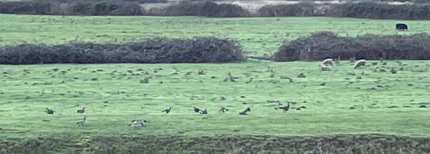

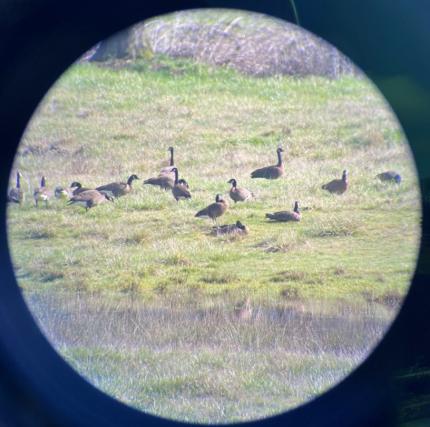
Treponeme-associated Hoof Disease (TAHD) Hoof Collection: Wildlife Conflict Specialist Aubrey and Customer Service Specialist Splitgerber responded to a report of an elk tangled up in a fence line along the road. By the time the elk was reached, it had broken free from the fence, but was not able to stand up. Aubrey suspected the elk had TAHD. After observing for a few minutes, Aubrey determined the elk needed to be euthanized. Both back hooves were infected, and all hooves were collected and transported for Washington State University’s ongoing research on TAHD.
Providing Recreation Opportunities
Silver Lake: Natural Resource Technician Celaya encountered a down tree in the Silver Lake parking lot. Fortunately, no serious damage was caused, and the tree was cleaned up within an hour, allowing ADA parking to be used unimpeded.


Site Cleanup in Klickitat County: Natural Resource Technician Celaya encountered a tree that fell at the Mineral Springs access site. The tree was first found hung up on a nearby oak. Celaya determined it was unsafe to remove the tree without additional help at the remote site. On a later date, Celaya returned with the help of Biologist Risley to clean up the tree.

Providing Conflict Prevention and Education
District 10 Terminally Ill Damage Hunt: Wildlife Conflict Specialist Aubrey worked with the Wildlife Program to find a hunting opportunity for a terminally ill hunter. Aubrey was able to send the hunter to a landowner experiencing damage to agricultural crops from elk. The hunter was successful in harvesting a cow elk on the first day at the property. It was reported to have been a limping elk, and after the hunter harvested the animal, he contacted Aubrey to ask if Washington Department of Fish and Wildlife needed the hooves. Aubrey met with the hunter to collect the hooves the following morning and transported them to Washington State University for ongoing research.
Managing Wildlife Populations
Marbled Murrelet Captures: Biologist Murphie assisted the Washington Department of Fish and Wildlife marine bird research team with their at-sea murrelet capture efforts. Samples collected at capture will provide information on the diet of these small sea birds. For this effort, the team was working near Port Townsend and Smith Island.
To catch these birds, capture teams drive small, rigid-hull, inflatable boats around at night using spotlights to find marbled or ancient murrelets. Once found, the boat maneuvers close enough to the marbled murrelet so that a crew member can catch them with a salmon-landing net. Biologist Murphie reported the team caught two ancient and three marbled murrelets on the nights he participated. Additional efforts continue.
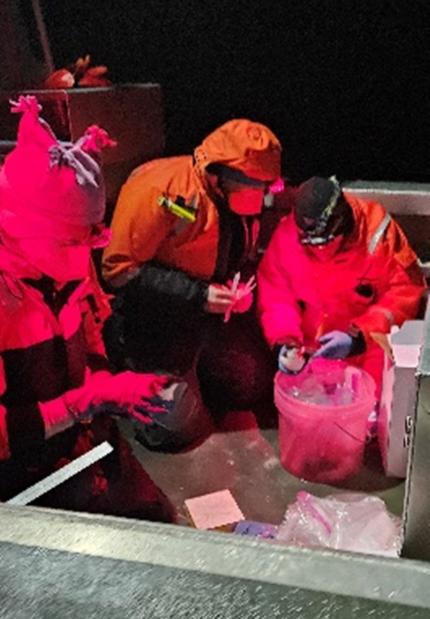
Conserving Natural Landscapes
Forest Health Planning: Wildlife Area Manager Laushman visited the Tarboo Unit of the North Olympic Wildlife Area with Forest Specialists Tveten and Nequette and a student researcher from Green River College to plan upcoming survey work for forest health improvements in the unit.
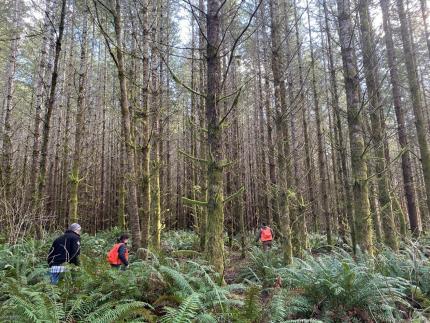
Nisqually Fence: Technician Norris added to the fence line along an eroding shore at the Nisqually Unit to improve public safety in the area.
South Puget Sound Cleanup: Members of the Clover Park Rotary Club and local Eagle Scouts helped clean up brush piles at the South Puget Sound Unit in Lakewood, consolidating them into an area where they can more readily decompose. This will allow space for prairie restoration.
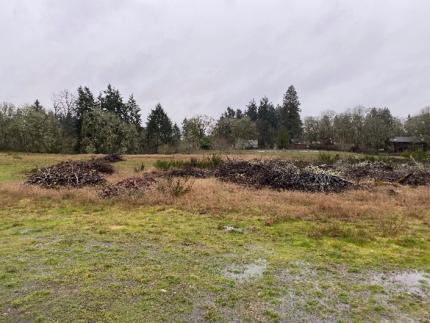
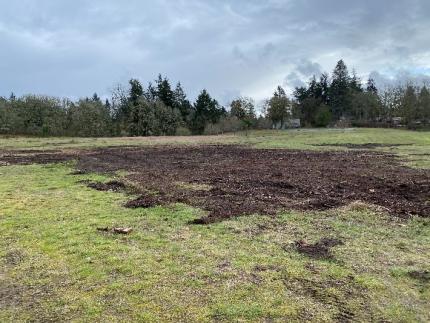
Conducting Business Operations and Policy
Safety Stand-up: Biologist Murphie participated in several activities associated with the agency-wide safety stand-up effort.